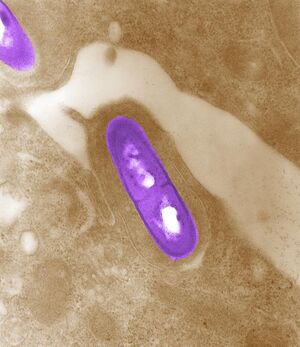Listeria swaminathanii
Listeria swaminathanii
Classification
Bacteria; Bacillati; Bacillota; Bacilli; Bacillales; Listeriaceae; Listeria; swaminathanii
Species
|
NCBI: [1] |
L. swaminathanii
Description and Significance
This strain was isolated in soil from the Great Smoky Mountains National Park. It is gram-positive rod-shaped bacterium. The species is nonpathogenic and can be handled safely in BSL 1 labs. Its discovery is important because of its classification as a sensu stricto species which could be misidentified as a pathogenic strain. For the food preparation industry this is may indicate potentially dangerous contamination. Its growth range is 0 to 45°C and grows optimally 30 to 37°C. It grows in anaerobic conditions as a facultative anaerobe. It can move independently using peritrichous flagella.
Genome Structure
The genome of listeria swaminathanii was assembled through microbiological technologies of hybrid Illumina and nanopore sequencing. There were two strains that were being analyzed through this work UTK C1-0015 which encompassed a partial monocin locus and a plasmid and UTK C1-0024 which had a full monocin locus and a prophage. Through multiple tests performed on this strain the genome showed a “98..7- 98.8% average nucleotide identity” (Hudson et al., 2022) The Sensu stricto listeria also showed the phenotypic characteristics of a catalase activity, glycerol metabolism, and starch metabolism.
Cell Structure, Metabolism and Life Cycle
Listeria swaminathanii is a Gram-Positive bacteria, meaning it has a thick peptidoglycan layer in its cell wall. This not only helps with structural integrity, but it also provides protection for the cell against the environment and harsh conditions. It allows the bacteria to survive in extreme temperatures and salt conditions. Listeria bacterium also possess flagella that helps with movement and motility, aiding in its ability to invade host cells. Once inside the host cell, listeria uses "actin-based motility" to move from cell to cell. The metabolic capabilities of Listeria are still not completely discovered yet. However, it has been proven that Listeria can use many different carbon sources as well as carbohydrates, amino acids, and other organic compounds. This once again helps the bacteria survive and adapt in the harsh host environment. A defining characteristic of Listeria's metabolism is it's ability to alternate between aerobic and anaerobic respiration depending on the environment. Listeria also has many virulence factors which aid in pathogen's attachment and invasion of the host cells. Some of these virulence factors include listeriolysin O and internalin proteins.
Ecology and Pathogenesis
Listeria swaminathanii is found in diverse habitats, including soil, freshwater, and decaying organic matter. It thrives in these environments as a free-living, motile bacterium. It interacts with microbial communities and plays a role in nutrient cycling, with its organic matter decomposition and carbon cycling. It has a high ability to persist in various environments and has great ecological adaptability.
While the biogeochemical significance of L. swaminathanii is less studied compared to other species, it may contribute to nutrient turnover and ecosystem balance, similar to its close relatives. Its interactions in soil and aquatic systems could impact microbial community dynamics and nutrient availability.
Pathogenic potential in humans or animals remains unclear, but other Listeria species are known to cause diseases like listeriosis. If pathogenic, L. swaminathanii might possess virulence factors such as listeriolysin O or surface proteins enabling host cell invasion. Potential symptoms in hosts could include fever, gastrointestinal distress, or systemic infections, as seen in other Listeria infections. Further research is required to determine its role in host-pathogen interactions.
References
Team, B. (2024, October 8). Listeria monocytogenes: Structure, pathways, and virulence. https://biologyinsights.com/listeria-monocytogenes-structure-pathways-and-virulence/
[Hudson LK, Chaggar HK, Schamp CN, Claxton ML, Bryan DW, Peters TL, Song Y, Carlin CR, den Bakker HC, Denes TG. Phenotypic characterization and analysis of complete genomes of two distinct strains of the proposed species "L. swaminathanii". Sci Rep. 2022 Jun 1;12(1):9137. doi: 10.1038/s41598-022-13119-y. PMID: 35650389; PMCID: PMC9159981.]
Carlin CR, Liao J,,Hudson LK, Peters TL, Denes TG, Orsi RH, Guo X, Wiedmann M. 2022. Soil Collected in the Great Smoky Mountains National Park Yielded a Novel Listeria sensu stricto Species, L. swaminathanii. Microbiol Spectr 10:e00442-22. https://doi.org/10.1128/spectrum.00442-22
Author
Page authored by Marin, Jakub, Jack, Jacob students of Prof. Bradley Tolar at UNC Wilmington.

